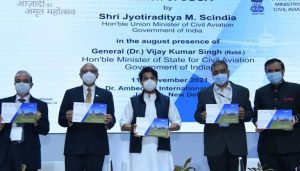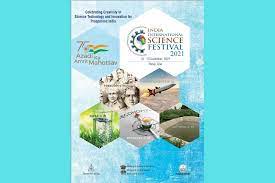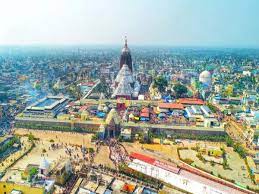Today Current Affairs: 19th November 2021 for UPSC IAS exams, State PSC exams, SSC CGL, State SSC, RRB, Railways, Banking Exam & IBPS, etc
Table of Contents
Pradhan Mantri Gram Sadak Yojana:

The Union Cabinet has approved the continuation of Pradhan Mantri Gram Sadak Yojana (PMGSY)-I, PMGSY-II, and Road Connectivity Project for Left-Wing Extremism Affected Areas (RCPLWEA).
- The CCEA approved the continuation of RCPLWEA up to March 2023.
- Areas that were not covered for road connectivity under phases one and two of Pradhan Mantri Gram Sadak Yojana or the Left-Wing Extremism affected areas RCPLWEA and the tribal areas are going to be benefited. Roads will be built through dense forests, mountains, and rivers.
- A total of one lakh 12 thousand 419 crore rupees, including state share, is likely to be incurred from 2021-22 to 2024-25 for completion of all the ongoing interventions of PMGSY.
- Road Connectivity Project for Left Wing Extremism Affected Areas was launched in 2016 for construction and up-gradation of 5,412 Km road length and 126 bridges of strategic importance in 44 districts in 9 states, including Andhra Pradesh, Bihar, Chhattisgarh, Jharkhand, Madhya Pradesh, Maharashtra, Odisha, Telangana, and Uttar Pradesh.
- 4,490 Km road length and 105 bridges have already been completed under RCPLWEA since 2016 in 44 districts in nine states.
E-Governance For Civil Aviation:

The Ministry of Civil Aviation has launched the e-Governance for Civil Aviation (e-GCA) online platform through which the Civil Aviation will provide 298 services including pilot licensing and medical examination.
- The launch of the e-GCA project under DGCA (Directorate General of Civil Aviation) was part of the 100-day plan for the aviation sector. The portal was developed by Tata Consultancy Services.
- It is a portal for the dissemination of information and providing online, speedy service delivery in a secure environment.
- It offers an end-to-end solution including several software applications, connectivity with all the regional offices.
- It will provide services to various DGCA stakeholders such as Pilots, Aircraft Maintenance Engineers, Air Traffic Controllers, Air Operators, Airport Operators, Flying Training Organizations, Maintenance and Design organizations, among others.
- It aims at enhancing the efficiency of the various services of DGCA and increasing accountability and transparency across all DGCA functions.
- Benefits:
- Eliminating operational inefficiencies
- Minimizing personal interaction
- Improving regulatory reporting
- Enhancing transparency
- Increasing productivity
7th Edition Of The India International Science Festival (IISF):

The Union Ministry of Earth Sciences (MoES) has recently launched the 7th edition of the India International Science Festival (IISF).
- Launched in 2015, IISF is an annual event considered to be the biggest platform in the country which brings together students, the public, researchers, innovators and artists from around the globe to experience the joy of doing science for the wellbeing of people and humanity.
- Organised by:
- IISF 2021 is being organised jointly by the Ministry of Earth Sciences (MoES), Ministry of Science & Technology (Department of Science & Technology, Department of Biotechnology, Council of Scientific and Industrial Research), in collaboration with Vijnana Bharati.
- IISF 2021 will be held from 10th-13th December in Panaji, Goa.
- Nodal Agency:
- The National Centre for Polar and Ocean Research, an autonomous institute under the MoES.
- Theme for 2021:
- Celebrating Creativity in Science, Technology and Innovation for Prosperous India.
- It will also reflect the spirit and idea of Aazadi ka Amrit Mahotsav of India, which aims to mark 75 glorious years of Indian independence in 2022.
Indus River Dolphin:

Punjab’s wildlife preservation wing has batted for conservation of Indus river dolphins and also their natural habitat.
- The Indus river dolphin was declared the State aquatic animal of Punjab in 2019.
- Scientific Name: Platanista gangetica minor
- According to a recent study of South Asian river dolphins, Indus and Ganges River dolphins are not one, but two separate species.
- Currently, they are classified as two subspecies under Platanista gangetica.
- Like other freshwater dolphins (such as Ganges river dolphins) , the Indus river dolphin is an important indicator of the health of a river.
- Other dolphins found in Indian waters include: Ganges River Dolphins, Irrawaddy dolphins.
- Habitat: They can only be found in the lower parts of the Indus River in Pakistan and in River Beas, a tributary of the Indus River in Punjab, India.
- Threats:
- Biological Resource Use: Fishing & harvesting aquatic resources.
- Natural System Modifications: Dams & water management/use.
- Pollution: Domestic & urban waste water, Industrial & military effluents, Agricultural & forestry effluents.
- Conservation Status:
- International Union for the Conservation of Nature (IUCN): Endangered.
- Convention on International Trade in Endangered Species(CITES): Appendix I
- Indian Wildlife (Protection), Act 1972: Schedule I
Puri Heritage Corridor Project:

The Odisha Government is expected to soon lay the foundation stone of the Puri heritage corridor, which is being developed at a cost of Rs 800 crore.
- The project is a part of the Augmentation of Basic Amenities and Development of Heritage and Architecture (ABADHA) scheme for developing Puri as a world-class heritage city.
- Conceived in 2016, the Puri Heritage Corridor Project was unveiled in December 2019 to transform the holy town of Puri into an international place of heritage.
- The project includes redeveloping major portions of the holy town and in the vicinity of the Jagannath temple for visitors and tourists.
- The project will include Shree Jagannath Temple Administration (SJTA) building redevelopment, a 600-capacity Srimandir reception centre, Jagannath cultural centre, Badadanda heritage streetscape, beachfront development, Puri lake, Musa river revival plan, etc..
Bribery Risk Matrix 2021:

Bribery Risk Matrix 2021 was released by TRACE, an anti-bribery standard setting organisation.
- It measures business bribery risk in 194 countries, territories, and autonomous and semi-autonomous regions.
- It was originally published in 2014 to meet a need in the business community for more reliable and nuanced information about the risks of commercial bribery worldwide.
- It aggregates relevant data obtained from leading public interest and international organisations, including the United Nations, World Bank, V-Dem Institute at the University of Gothenburg and World Economic Forum.
- Calculation Methods: Score is calculated on the basis of four factors:
- Enforcement and anti-bribery deterrence.
- Business interactions with the government.
- Government and civil service transparency.
- Capacity for civil society oversight which includes the media’s role.
Performance of the Countries:
- India has slipped to 82nd position in 2021, five places down from 77th rank last year.
- In 2020, India ranked 77 with a score of 45 while this year, the country stood at 82nd position with a score of 44.
- India fared better than its neighbours – Pakistan, China, Nepal and Bangladesh. Bhutan, meanwhile, secured 62nd rank.
- World: North Korea, Turkmenistan, Venezuela and Eritrea pose the highest commercial bribery risk, while Denmark, Norway, Finland, Sweden and New Zealand present the lowest.
- Over the past five years, the business bribery risk environment in the United States worsened significantly when compared with global trends.
- From 2020 to 2021, all of the Gulf Cooperation Council (GCC) countries saw an increase in commercial bribery risk.
Digital India Land Record Modernisation Programme (DILRMP):

The Ministry of Rural Development inaugurated ‘Bhumi Samvaad’ – National Workshop on Digital India Land Record Modernisation Programme (DILRMP).
- The Ministry also launched the National Generic Document Registration System (NGDRS) portal and Dashboard.
- The DILRMP was approved by the Cabinet on 21st August, 2008.
- For modernization of land records system in the country, a modified programme, viz., the National Land Records Modernization Programme (NLRMP), now renamed as Digital India Land Records Modernization Programme (DILRMP), has been formulated.
- Two Centrally sponsored schemes of Computerization of Land Records (CLR) and Strengthening of Revenue Administration and updating of Land Records (SRA&ULR) were merged.
- It is a Central Sector scheme that has been extended to 2023-24, to complete its original targets as well as expand its ambit with a slew of new schemes.
- It attempts to build upon the commonalities that exist in the arena of land records in various States to develop an appropriate Integrated Land Information Management System (ILIMS) across the country, on which different States can also add State-specific needs as they may deem relevant and appropriate.
- ILIMS: The system contains information on parcel ownership, land use, taxation, location boundaries, land value, encumbrances and many more.
- It is being implemented by the Department of Land Resources (Ministry of Rural Development).
- Aim: To usher in a system of updated land records, automated and automatic mutation, integration between textual and spatial records, inter-connectivity between revenue and registration, to replace the present deeds registration and presumptive title system with that of conclusive titling with title guarantee.
National Epilepsy Day:

The National Epilepsy Day was observed on November 17, 2021.
- Epilepsy is a chronic non-communicable disease of the brain that affects around 50 million people worldwide.
- It is characterized by recurrent seizures, which are brief episodes of involuntary movement that may involve a part of the body or the entire body and are sometimes accompanied by loss of consciousness and control of bowel or bladder function.
- Nearly 80 per cent of people with epilepsy live in low and middle-income countries. Therefore, it is significant to make people aware of the condition and reduce the number of affected people.
- Although epilepsy is treatable, yet three-fourths of affected people in developing countries do not receive the required treatment. In many parts of the world, people with epilepsy and their families suffer from stigma and discrimination.
International Students Day:

The International Students’ Day is being observed on November 17, 2021.
- The day is celebrated every year to focus on availing education for all students.
- The day aims to ensure that every student has access to education around the globe.
- The mission for the day is to encourage students to think beyond traditional career opportunities, prepare for future careers and entrance into the workplace.
- This day was chosen to be commemorated as the International Students’ Day due to the events that took place in Prague during World War-II.
16th Edition Of The Annual Status Of Education Report (ASER 2021):

The percentage of rural children who were not enrolled in school doubled during the pandemic, with government schools seeing an increase in enrolment at the expense of private schools, according to the Annual Status of Education Report (ASER), 2021.
- Over a third of children enrolled in Classes 1 and 2 have never attended school in person.
- However, enrolment does not necessarily mean that learning took place.
- In a survey of over 76,000 households with children aged six to 14, ASER found that while 92% of children had textbooks for their grade, only a third had access to any other learning resources or support.
- With smartphone availability and access limited, online learning was restricted to a quarter of students, though there were major differences in the experience of students from different States.
- For instance, 91% of students from Kerala and almost 80% from Himachal Pradesh had online education, but only 10% from Bihar and 13% from West Bengal.




